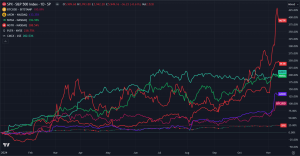I bought HSBC (LSE: HSBA) shares relatively recently with some of the proceeds from selling my Lloyds holding.
A key reason is the much larger passive income I can make from the former. There is also a much greater chance of their making price gains as well, I think.
Big passive income generator?
£10,000 would currently buy me 1,453 shares in the bank.
Analysts’ expectations are that its total dividend by the end of this year will be 65p a share. This does not include the special 17p dividend announced earlier this year following the sale of its Canadian business.
This 65p payout would give a yield of a stunning 9.4% — one of the highest in the FTSE 100.
At this rate, my HSBC shares would pay me £940 in dividends in the first year.
After 10 years, I would have made an extra £9,400 in dividends. This is provided the yield averaged the same and that I removed my money each year from my investment pot.
However, if I used those dividends instead to buy more HSBC shares then I would make a lot more than that.
By doing this (‘dividend compounding’) I would have an extra £15,506 instead of £10,097!
After 30 years on the same average yield, the total investment pot would be worth £165,935. This would pay me £14,832 a year by that point, or £1,236 each month!
Potential share price gain too?
When buying high-dividend-paying stocks, I look carefully at their share price valuation.
If it looks undervalued, there is less chance of my dividend gains being wiped out by sustained share price losses. I also stand a greater chance of making money from a share price rise as well.
HSBC trades on the key price-to-earnings (P/E) stock valuation measurement at 7.2. This compares to a UK peer group average of 7.3, so it looks slightly undervalued on that basis.
However, it looks even cheaper against its European peer group average of 7.7.
So, how cheap is it? A comprehensive discounted cash flow analysis shows HSBC to be 53% undervalued right now. Therefore, a fair value would be £14.64, although there is no guarantee it will ever reach that level.
How does the business look?
Like all firms, its share price and dividend are supported by earnings and profits.
The main risk for the bank is a declining net interest margin (NIM), in line with falling interest rates. The NIM is the difference between the interest a bank receives on loans and the rate it pays for deposits.
However, its Q1 2024 results showed revenue up 24% year on year (to $20.8bn), while net income rose 2.5% over the same period (to $10.6bn).
Right now, analysts’ estimates are that revenue will grow at 3.5% a year to end-2026. Return on equity is forecast to be 12.3% by that time.
I will buy more HSBC shares simply for the potential high yield. But the likelihood in my view of a significant share price rise over time adds further weight to my decision.
This post was originally published on Motley Fool







